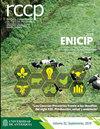Multi-objective optimization of methionine+cysteine levels in diets for growing pigs
IF 0.5
4区 农林科学
Q4 AGRICULTURE, DAIRY & ANIMAL SCIENCE
引用次数: 0
Abstract
Background: The addition of synthetic methionine to growing pig diets should consider the requirements of the methionine+cysteine complex, as most cysteine is obtained through dietary methionine. Objective: To determine an optimal level of methionine+cysteine (Met+Cys) in growing pig diets. Methods: Ninety-nine hybrid (Yorkshire×Landrace×Duroc) barrows were used in a completely randomized design (initial body weight: 25.90±3.99 kg). Nine levels of Met+Cys (0.500, 0.525, 0.550, 0.575, 0.600, 0.625, 0.650, 0.675, and 0.700%) were evaluated during 35 days. To determine a multi-objective optimal level of Met+Cys, growth performance and strongly related carcass traits were evaluated. Results: Average daily feed intake (ADFI) and feed:gain ratio (FGR) showed a linear response to the dietary Met+Cys level (p<0.05), with estimated optimal concentration at 0.700%. Average daily gain (ADG) did not show any effect on the Met+Cys level (p>0.05). Carcass characteristics were not affected by the Met+Cys concentration (p>0.05). The multi-objective optimal level for ADG, ADFI, and FGR was 0.667% Met+Cys. Conclusions: According to our results, 0.667% Met+Cys is the best concentration in diets for growing pigs.生长猪饲粮蛋氨酸+半胱氨酸水平的多目标优化
背景:在生长猪日粮中添加合成蛋氨酸应考虑蛋氨酸+半胱氨酸复合物的要求,因为大多数半胱氨酸是通过日粮蛋氨酸获得的。目的:确定生长猪日粮中蛋氨酸+半胱氨酸(Met+Cys)的最佳水平。方法:采用完全随机设计的方法,选用99头(约克郡×长白×杜洛克)杂交公猪(初始体重:25.90±3.99kg)。在35天内评估了9个Met+Cys水平(0.500、0.525、0.550、0.575、0.600、0.625、0.650、0.675和0.700%)。为了确定Met+Cys的多目标最优水平,对生长性能和强相关胴体性状进行了评估。结果:平均日采食量(ADFI)和料重比(FGR)与日粮Met+Cys水平呈线性关系(p0.05)。Met+Cys浓度不影响胴体性状(p>0.05)。ADG、ADFI和FGR的多目标优化水平为0.667%Met+Cys。结论:根据我们的研究结果,0.667%的Met+Cys是生长猪日粮中的最佳浓度。
本文章由计算机程序翻译,如有差异,请以英文原文为准。
求助全文
约1分钟内获得全文
求助全文
来源期刊

Revista Colombiana De Ciencias Pecuarias
AGRICULTURE, DAIRY & ANIMAL SCIENCE-
CiteScore
0.80
自引率
0.00%
发文量
18
审稿时长
6-12 weeks
期刊介绍:
The editors of Revista Colombiana de Ciencias Pecuarias (RCCP) welcome the submission of original manuscripts on experimental and clinical studies associated with the broad areas of animal sciences and veterinary medicine as they interface with biochemistry, molecular biology, physiology, pharmacology, toxicology, pathology, microbiology, parasitology, immunology and epidemiology. The scope of the journal includes studies of basic and applied research in animal management and production, feeding and nutrition, reproduction, breeding, genetics, animal welfare and behavior; as well as animal production focussed from biotechnology, soil science, agrostology, silvopastoral systems, livestock economics and the environment.
The criteria for acceptance of papers submitted for publication are originality, quality and clarity of the content. Each contribution must be based on original, unpublished research that has not been simultaneously submitted to other journals. All papers will be peer reviewed. All authors bear responsibility for ensuring the integrity and quality of their reported research. It is the author''s responsibility to secure permission to use figures or tables that have been published elsewhere.
Contributions may be classified as original research, review, rapid communication, clinical case studies or methodological articles, as well as news/commentaries or letters to the editor. Most review articles are invited by the editor. Authors interested in submitting a review article should contact the corresponding editor. Rapid publication of original manuscripts is a goal of the journal. Manuscripts must be written in English. Each manuscript is considered for publication with the understanding that it has not been simultaneously submitted to any other journal. Upon acceptance for publication, papers are subject to editorial review and revision.
 求助内容:
求助内容: 应助结果提醒方式:
应助结果提醒方式:


